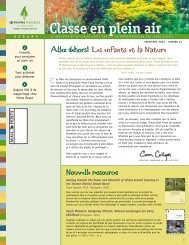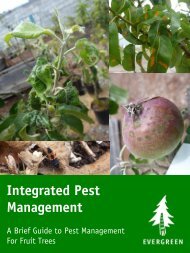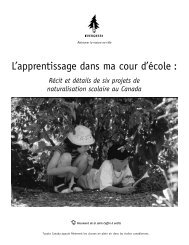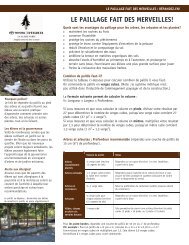INVASIVE PLANT PROFILE - Evergreen
INVASIVE PLANT PROFILE - Evergreen
INVASIVE PLANT PROFILE - Evergreen
You also want an ePaper? Increase the reach of your titles
YUMPU automatically turns print PDFs into web optimized ePapers that Google loves.
Dawn Hanna<br />
Why is Iris pseudacorus a problem?<br />
Iris pseudacorus is native to Europe and the British Isles, North Africa and the Mediterranean<br />
region. It has been transplanted into well-watered gardens all over the world and has widely<br />
escaped. It is used in sewage treatment, and is known to be able to remove metals from wastewaters.<br />
However, yellow iris is also a rapid growing perennial that colonizes into large numbers.<br />
It spreads by both underground rhizomes and seeds, and can spread downstream by<br />
broken rhizomes which re-root. It forms very dense thickets that displace other native plants<br />
including sedges and rushes and altering animal habitat. The creation of thickets also results in<br />
restricting water flows, affecting irrigation canals and flood control ditches. All parts of this plant<br />
are poisonous. It has been known to sicken cattle when they eat it.<br />
Controlling this aquatic invader presents challenges as manual control has limited impact, and<br />
chemical control is typically avoided due to the proximity to water sources. This can be seen in<br />
the work of the Comox Valley Naturalists Society. Members have been removing Iris pseudacorus<br />
from the Courtenay River estuary area. The considerable viable seed bank in the soil has meant<br />
that areas disturbed in the process of removing yellow flag iris corms are often re-colonized with<br />
yellow flag seedlings from the seed bank. Stewards have found it necessary to hoe or weed most<br />
areas a couple of times to stop re-establishment. Additionally, areas that were removed of blackberries<br />
and replanted with native grasses and herbs required the weeding of thousands of yellow<br />
flag iris seedlings that sprouted from the ever-present seed bank. From 2002-2005, 11,996kg of<br />
Iris pseudacorus were removed.<br />
See http://plants.usda.gov/java/profile?symbol=IRPS for more information on I. pseudacorus.<br />
How is Iris pseudacorus controlled once a site is invaded?<br />
Iris pseudacorus is difficult to control. Extensive rhizomes in established infestations can mean<br />
that machines may be the only possibility for management. In sensitive areas such as stream beds,<br />
machine removal may exacerbate invasive problems. Mechanical removal can cause extensive<br />
disturbance to the substrate and result in creating conditions for the establishment of other<br />
unwanted plants. Fire has been used with some success. If attempting manual removal of small<br />
infestations by pulling or digging, note the following:<br />
<strong>Evergreen</strong><br />
<strong>INVASIVE</strong> <strong>PLANT</strong> <strong>PROFILE</strong><br />
Yellow Flag Iris, Yellow Flag<br />
Iris pseudacorus<br />
Family: Iris Zone 4-7<br />
• Resinous substances in the leaves and rhizomes can cause skin irritation. Wear gloves<br />
and appropriate clothing.<br />
• Remove entire rhizome root system<br />
• Remove seed pods to help control population expansion<br />
• Re-visit sites in subsequent seasons to ensure eradication is complete.<br />
I. pseudacorus is a local problem in<br />
Jericho Park. A 1996 plant survey of<br />
the Park yielded no record of yellow<br />
flag. In 2004, volunteer steward<br />
John Coope counted 1,000 stems of<br />
yellow flag in the marsh. This year,<br />
he counted 5,000 — a five-fold<br />
increase in less than two years.<br />
Jericho Stewardship Group<br />
Ernie Sellintin<br />
Plant description<br />
This herbaceous, aquatic perennial<br />
plant grows 1 – 1.25 meters tall. It<br />
has large, showy, pale to deep yellow<br />
flowers on erect stalks. Flowers<br />
bloom in the summer. The leaves<br />
are erect, flattened, sword-like.<br />
They rise in a fan from the soil.<br />
Rhizomes are 1-4 cm in diameter<br />
and the roots are 10-30 cm long.<br />
Seed pods are glossy green. I.<br />
pseudacorus grows in water to<br />
25cm deep, or near water as in<br />
creek and pond edges. It tolerates<br />
high soil acidity, has a high nitrogen<br />
requirement, and can grow in both<br />
saltwater and freshwater.
1<br />
2<br />
3<br />
4<br />
Market Alternatives<br />
There are other plants which provide the benefits of Iris pseudacorus, such<br />
as producing attractive flowers, but that do not negatively impact plant and<br />
animal habitat or alter water flows.<br />
Wild flag iris Iris setosa The leaves of Wild Flag Iris are grey green with mediumsized<br />
red-purple to blue-purple blooms in late spring and summer. Plant beside<br />
water features, in wet borders or massed. It tolerates acid soils, making it suitable<br />
for coastal gardens.<br />
SUN, MOIST, 35CM-70CM TALL<br />
Blue-eyed grass Sisyrinchium idahoense This perennial is from the iris family with<br />
grass like foliage and a striking blue flower with a yellow centre. Suggested for<br />
moist, well-drained sites beside water features, in meadow-like settings, or as<br />
a specimen.<br />
NATIVE SPECIES, SUN/PART SHADE, MOIST/DRY<br />
Siberian iris Iris siberica This iris is a good alternative for those looking for yellow<br />
iris flowers. The blooms also come in a range of other colours including shades of<br />
blue and pink. It has narrow almost grass-like leaves and the flower stems tend to<br />
be upright. This plant is tolerant of acid soil. Suitable for moist borders, massed and<br />
beside water features.<br />
SUN, MOIST, SIZES VARY.<br />
Japanese iris Iris ensata This tall iris has large blooms ranging from 10-20cm<br />
across. Colours come in purple, violet, pink, white, rose, and red. The narrow leaves<br />
are upright and graceful. Tolerant of acid soils. Suitable beside water features, in<br />
moist borders and massed.<br />
SUN, MOIST, 120CM TALL<br />
5 Marsh marigold Caltha palustris This moisture-loving perennial has low mounding,<br />
bright green foliage that contrasts nicely with its spring yellow flowers. A natural<br />
choice for wetlands and beside water features.<br />
NATIVE SPECIES, SUN/ PART SHADE, WET, 30CM-46CM TALL<br />
5<br />
www.evergreen.ca<br />
Vancouver Office<br />
#404-134 Abbott St. Vancouver BC<br />
V6B 2K4, Canada<br />
infobc@evergreen.ca Tel: 604-689-0766<br />
1<br />
2<br />
3<br />
4<br />
Thanks to our project sponsors<br />
Heritage Perennials©<br />
Heritage Perennials©<br />
Heritage Perennials©<br />
Heritage Perennials©<br />
Heritage Perennials©















